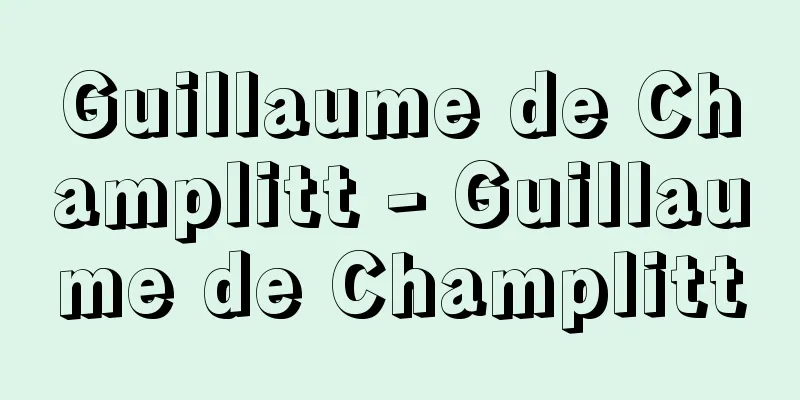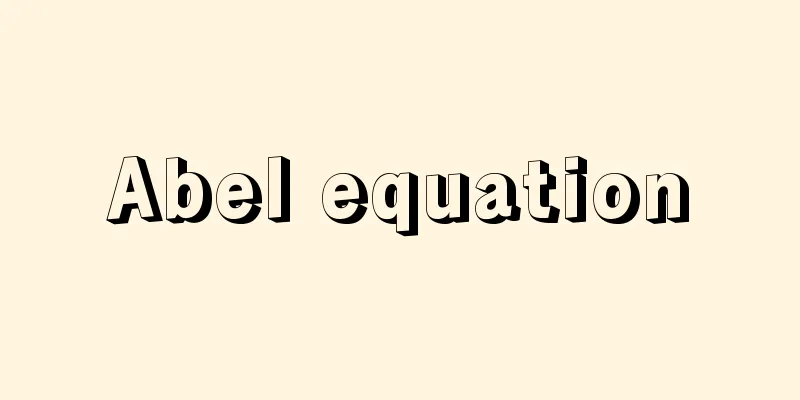French Music

|
In 870, the Frankish Kingdom was divided, and the area that became the West Frankish Kingdom roughly corresponds to present-day France. From this period onwards, France began to show its own unique musical identity, and together with Italy and Germany, it continued to play a central role in the evolution of European music. [Yoshio Miyama] historymiddle agesAfter the introduction of Christianity, local liturgies and chants were developed around the 4th century. This was called chant gallican, but it declined as the unification of church chants was promoted. Instead, Metz in northeastern France became one of the important places for the development of Gregorian chant, a unified chant, and its notation. After the 9th century, it became the center of the creation of sequences, a type of Gregorian chant, and the development of polyphonic music based on chants. The latter was called organum, and was developed in northern France at first, and in the 12th century, Limoges in the southwest. As cities were formed in the second half of the 12th century, organum creation also took place in cities. In particular, Leoninus, a musician at Notre Dame Cathedral in Paris, left behind many long organums based on chants. In secular music, poets and composers called troubadours were active in the courts of southern and southwestern France in the 12th century, and wrote songs about courtly love with a chivalrous background. This art spread to central and northern France, and led to the creation of songs by the troubadours. The 13th century was the center of the troubadours' activities, and in addition to courtly love, they created songs related to the Crusades. In the 13th century, polyphony was introduced into secular music, and a type of music in which multiple vernacular lyrics were sung simultaneously was called a motet. In the 14th century, a new rhythmic principle (isorhythm) was invented, in which the same rhythmic pattern is repeated many times within a piece of music. The title of the theoretical book by Philippe de Vitry that explained this, Ars Nova, is sometimes used to describe the music of this century. Along with Vitry, another musician who represents this century is Guillaume de Machaut, who was active as a poet and diplomat, but also composed secular songs such as ballades, rondeaux, and villeins that made use of poetic forms, aiming to incorporate human emotions in a more subtle and conscious way into music. [Yoshio Miyama] RenaissanceThe Duchy of Burgundy, which had been powerful since the beginning of the 15th century, prospered in northern France and Flanders, and encouraged artistic creation. The Duchy's musician Gilles Binchois (c. 1400-60) composed many three-part chansons, pioneering elegant and refined expression. On the other hand, the style of English music, as represented by Dunstable, which sought rich chords, had a strong influence on France. Guillaume Dufay synthesized these two elements, and his polyphonic writing, which was technically rich in harmony and balance, determined the direction of Renaissance music. Most of the leading musicians of this era were from northern France and Flanders, and they were active internationally across Europe. For this reason, musicians from this region, such as Dufay, Josquin des Prez, and Lassus, are called the Franco-Flemish or Flemish school, and they left behind religious songs such as masses and secular songs in various languages all over Europe. Influenced by the Franco-Flemish school, the creation of chansons with more popular content and clear style flourished in the 16th century. The representative composer was Clément Janequin, whose works were widely circulated due to the printing of musical scores that began at that time. In 1570, the "Academy of Poetry and Music" was founded in Paris, and vocal music was created through the cooperation of poets and musicians from the Pleiade school. [Yoshio Miyama] BaroqueDue to the centralized rule of the Louis Dynasty, musical activity was concentrated in Paris and Versailles. Court music was divided into three parts: outdoor, indoor, and church, and compositions were created in each of these areas seeking a magnificent style that symbolized royal power. Lully, who controlled all court music, worked hard to create French-style opera, and began to publish the results of his work in the 1670s. Couperin's rococo-sensitive harpsichord music and chamber ensemble music, and Rameau's operas are representative of the 18th century. Military music that responded to the times became popular during the French Revolution, but there was a lack of notable artistic musical creations. [Yoshio Miyama] 19th centuryAround 1830, the grand opera with its spectacular grandeur, composed by Rossini, Meyerbeer, Auber, and Haléby, was in vogue, but in the second half of the 19th century, lyric opera with its graceful and sweet musical style, composed by Gounod, Delibes, Thomas, Massenet, and others, gained popularity. Bizet also introduced realism to French opera with Carmen (1875). Other notable works include the development of program music by Berlioz (Symphonie Fantastique, 1830) and the promotion of uniquely French instrumental and chamber music by the Société National de Musique (founded in 1871). After Gounod, the creation of songs that combined the diction of poetry with music and nature became popular. [Yoshio Miyama] Late 19th century to 20th centuryDebussy's impressionist music (Prelude to the Afternoon of a Faun, 1894) overcame romanticism and created a new sound image. After many individualists such as Ravel and Satie emerged, the generation born in the last decade of the 19th century after World War I aimed to create music with clear structures and fresh harmonies from an anti-romantic standpoint. Representatives of this generation were Milhaud and Poulenc, both of whom belonged to the group known as the "Sexteur". Messiaen, who began releasing works in the 1930s, was considered the most important French composer of the 20th century for his compositional techniques such as rhythm and harmony, and his mystical expressions. Boulez, who developed his own unique compositional technique called "serie", explored the possibilities of new expressions and musical composition, and in 1975 became director of the national research institute for acoustics and music, IRCAM. [Yoshio Miyama] FeaturesFrench music rejected both the Italian pursuit of vocal quality and the German tendency to express inner feelings, and instead sought harmony and balance between expression and content, and an expression that was rational and moderate. Secondly, French music has always been sensitive to the rhythm and intonation of words, and has consistently striven to turn poetic diction into music in a natural way, as seen in Renaissance chansons, Lully's operas, and modern songs. This resulted in being on the same track as French Academism, which aimed to refine and protect the French language itself. The third characteristic is an excellent sense of color. Since the Baroque period, the trend towards light, transparent and diverse tones has become evident through improvements in instruments, but Berlioz, in his book Modern Instruments and Orchestration, explored and systematized the use of instruments in the orchestra, paving the way for the use of a variety of tones and color effects. A sense of color is also an important element in the modern French music of Debussy, Ravel, Messiaen and others. Fourthly, the works are characterized by their precise composition and logical structure. They do not like unlimited expansion of works, but rather limit the scale, clearly logically define the principles of their composition, and carefully select every single sound and note down to the smallest detail. This tendency is particularly evident in modern and contemporary music. However, it can also be said that this tendency was already evident in the 14th century technique of composing music based on rhythm, known as isorhythm. This tendency is also connected to the clear-sighted critical spirit that is a tradition in French culture. French music is also often linked to concrete images other than music. Couperin said about his own clubs, "Various opportunities are the source of my compositions, and the titles correspond to my musical ideas at the time." In the Baroque era, the tendency to dislike abstract fugues and partitas and to prefer poetic and fantastical program music was already clear. Many symphonies and concertos in the 19th century also had titles, while the creation of highly abstract genres such as sonatas and string quartets was sluggish. Impressionist music also does not have titles in the traditional sense, in that it replaces external images projected on the mind with music, but it can be said to belong to this lineage in a macroscopic sense. Furthermore, the importance of ballet in French music must be emphasized. France's love of dance and ballet became a prominent feature of the Renaissance, and the composition of elegant court dances such as the pavane and court ballets, beginning with Les Ballets Comiques de la Reine (1581), flourished. Ballet was an essential element of French opera from the Baroque period through to the 19th century, so much so that Wagner even added ballet scenes and music specifically to his own operas when they were performed in Paris. [Yoshio Miyama] Folk musicBrittany and Provence have their own folk songs and dances, but folk music is also part of a sedimentary culture that spread from the cities to the countryside and from the upper to the lower classes of society. Therefore, its characteristics are similar to art music. Most of this folk music is in major keys, has regular meters, and is structured with refran (repeated phrases). Also, compared to the folk music of other Western countries, there is a high proportion of songs in church modes and 3-beat music. Most folk songs are in a 1-syllable 1-note pattern, which is a striking difference from Italy, where pop melodies are dominant. This consideration of the balance between words and sounds and the above-mentioned structural features are also the basis of modern and contemporary chanson. In Brittany, 2-beat music is the norm, which is very different from other regions, but this is probably the result of close ties with England. [Yoshio Miyama] "History of French Music" by N. Dufourc, translated by Toyama Ikko, Hirashima Masao, et al. (1972, Hakusuisha)" ▽ "Eleven Men of French Music - From Gounod to Debussy" by Robert Pitroux, translated by Fujiwara Yutaka (1973, Ongaku No Tomosha) ▽ "Baroque Society and Music, Volume 1" by Imaya Kazunori (1986, Ongaku No Tomosha) ▽ "Collected Works of Toyama Ikko, Volume 4" by Toyama Ikko (1987, Shinchosha) ▽ "Performance and Interpretation of French Songs" by Pierre Bernac, translated by Hayashida Kimiko (1987, Ongaku No Tomosha) ▽ "The French Six - Portraits of Parisian Musicians of the 1920s" by E. Hullard Villetard, translated by Tobihata Yuki (1989, Shobunsha)" ▽ "An Introduction to Modern and Contemporary French Music by Isoda Kenichiro - Listening to it like Satie (1991, Ongaku No Tomosha)" ▽ "A Guide to the Music of the Paris Expo by Inoue Satsuki (1998, Ongaku No Tomosha)" ▽ "Ezoterism in Music - A Genealogy of the Unexplored Music of France 1750-1950" by Jocelyn Godwin, translated by Takao Kenji (2001, Kousakusha)" ▽ "When the 'modern' period of music began - Musicians under the Second Empire" by Asai Kaori (Chuko Shinsho)" ▽ "French Classical Music by Paillard, translated by Watanabe Kazuo (Hakusuisha, Que sais-jes paperback)" ▽ "French and German Lied by E. Luther, translated by Komatsu Kiyoshi and Ninomiya Reiko (Hakusuisha, Que sais-jes paperback)" ▽ "James R. Anthony French Baroque Music; From Beaujoyeulx to Rameau(1974, WW Norton, New York)” ▽ “Isabelle CazeauxFrench Music in the Fifteenth and Sixteenth Century(1975, Oxford University Press, New York)” [References] | | | | | | | | | | | | | | | | |Delibes| | | | | | | | | | | |Massenet| | | | | |Source: Shogakukan Encyclopedia Nipponica About Encyclopedia Nipponica Information | Legend |
|
870年にフランク王国が分割され、西フランク王国となった地域がほぼ現在のフランスに相当する。この時期から音楽面でも独自性を示すようになり、イタリア、ドイツとともにヨーロッパ音楽の変遷のなかで中心的な役割を果たし続けた。 [美山良夫] 歴史中世キリスト教が伝えられたのち、4世紀ごろから独自の地方的典礼と聖歌が育成された。これはガリア聖歌chant gallicanとよばれるが、教会聖歌の統一が推進されると衰退、かわって北東フランスのメッスなどが統一的な聖歌であるグレゴリオ聖歌の歌唱と記譜法発達のうえで重要な場所の一つとなった。9世紀以後は、グレゴリオ聖歌の一種であるセクエンツィアの創作、聖歌をもとにしたポリフォニー音楽発展の中心となった。後者はオルガヌムとよばれ、当初は北フランスが、12世紀には南西部のリモージュが発展の中心であった。12世紀後半に都市の形成が進むと、オルガヌム創作も都市が中心となり、なかでもパリのノートル・ダム大聖堂の音楽家レオニヌスは、聖歌をもとにした長大なオルガヌムを多数残した。 世俗音楽では、12世紀に南部および南西部フランスの宮廷でトルーバドゥール(吟遊詩人)とよばれる詩人兼作曲家が活躍、騎士道精神を背景にした宮廷的恋愛をテーマにした歌を残した。この芸術は中部および北部フランスに伝えられ、トルーバドゥールによる歌曲創作をもたらした。トルーバドゥールの活躍の中心は13世紀で、宮廷的恋愛のほか、十字軍に関連した歌が生まれた。13世紀にはポリフォニーが世俗音楽にも導入され、複数の俗語歌詞を同時に歌うタイプの音楽はモテットとよばれた。 14世紀には、同じリズム・パターンを楽曲中で何度も反復するという新しいリズム原理(イソリズム)が創案された。これを説明したフィリップ・ド・ビトリの理論書の題名『アルス・ノバ』を、この世紀の音楽を表すことばとして使うこともある。ビトリとともにこの世紀を代表する音楽家はギヨーム・ド・マショーで、彼は詩人、外交官として活躍する一方、詩の形式を生かしたバラード、ロンドー、ビルレーという世俗歌を作曲、人間感情を細やかに、より意識的に音楽に盛り込むことを目ざした。 [美山良夫] ルネサンス15世紀初頭から力をもったブルゴーニュ公国は、北フランス、フランドルも勢力下にして繁栄、芸術創作の活性化を促した。公国の音楽家バンショアGilles Binchois(1400ころ―60)は三声のシャンソンを多く作曲、優美で洗練された表現を開拓した。他方、ダンスタブルに代表されるイギリス音楽の、和音の豊かな響きを求めたスタイルはフランスに強い影響を与えた。この二つの要素を総合したのはギヨーム・デュファイで、技巧的でありながら調和と均衡感に満ちたポリフォニー書法は、ルネサンス音楽の方向を決定づけた。この時代の指導的音楽家の大半は北フランスおよびフランドル地方出身で、国境を越えヨーロッパ各地で国際的に活躍した。そのためデュファイ、ジョスカン・デ・プレ、ラッススらこの地方出身の音楽家はフランコ・フランドル楽派ないしフランドル楽派とよばれ、彼らはヨーロッパ各地でミサ曲などの宗教曲、各国語による世俗歌を残した。 フランコ・フランドル楽派の影響を受けつつ、16世紀にはいっそう庶民的な内容、明快なスタイルによるシャンソンの創作が隆盛化した。その代表的作曲家はクレマン・ジャヌカンで、彼の作品は当時始まった楽譜の活版印刷により広く流布した。1570年にはパリに「詩と音楽のアカデミー」が設立され、プレイアード詩派の詩人と音楽家の協力による声楽曲創作が試みられた。 [美山良夫] バロックルイ王朝による中央集権的な支配により、音楽活動はパリとベルサイユに集中した。宮廷の音楽は、野外、室内、教会の3部分に分割され、それぞれ王権を象徴する壮麗な様式を求めた創作が行われた。宮廷の音楽をすべて支配したリュリは、フランス様式のオペラ創作に尽力、1670年代からその成果を発表した。クープランのロココ的繊細さをもったクラブサン(チェンバロ)音楽と室内合奏曲、ラモーのオペラは、18世紀を代表するものである。フランス革命期には時代に呼応した軍楽が盛んになったが、芸術的に目だった音楽創作は乏しかった。 [美山良夫] 19世紀1830年前後は、ロッシーニ、マイヤベーア、オーベール、アレビーによる壮大なスペクタクル的見せ場をもつグラン・トペラ(グランド・オペラ)が流行したが、19世紀後半はグノー、ドリーブ、トマ、マスネらによる優美で甘美な音楽様式を備えたリリック・オペラが人気を獲得した。また、ビゼーは『カルメン』(1875)により、リアリズムをフランス・オペラに導入した。オペラ以外では、ベルリオーズによる標題音楽の発展(『幻想交響曲』1830)、国民音楽協会(1871設立)によるフランス独自の器楽、室内楽の推進が注目される。また、グノー以後、詩のディクションを音楽と自然に結び付ける歌曲の創作が盛んになった。 [美山良夫] 19世紀末~20世紀ドビュッシーによる印象主義音楽(『牧神の午後への前奏曲』1894)がロマン主義を克服して、新しい音響像をつくりあげた。ラベル、サティら多くの個性を輩出したのち、第一次世界大戦後には19世紀の最後の10年余に生まれた世代が、反ロマン主義の立場から、明快な構造と新鮮な和声による音楽づくりを目ざした。この代表はミヨーとプーランクであり、ともに「六人組」とよばれる作曲家に属している。1930年代から作品を発表したメシアンは、リズムや和声などの作曲技法、神秘主義的な表現で、20世紀フランスのもっとも重要な作曲家とみなされた。またセリーという作曲技法を独自に展開したブーレーズは、新しい表現と音楽構成の可能性を探求、75年には国立の音響・音楽研究所IRCAM(イルカム)の所長になった。 [美山良夫] 特徴フランス音楽は、イタリア音楽の歌唱性の追究、ドイツ音楽の内的感情の表現への傾斜をともに排し、表現と内容との調和や均衡、理性と節度をもった表情を求めた。次に、ことばのリズム、抑揚についてつねに敏感であり、ルネサンス時代のシャンソン、リュリのオペラ、近代歌曲など、一貫して詩のディクションをいかに自然に音楽化するかに努力が払われてきた。これは、フランス語自体の洗練と擁護を目標としたフランスのアカデミズムと結果的に軌を一にするものである。 第三の特徴は、優れた色彩感覚にある。バロック時代から楽器の改良を通じて、軽く透明で多彩な音色を求める傾向は明らかになったが、ベルリオーズは著書『近代の楽器法と管弦楽法』で、管弦楽における楽器の使用法を探究、体系化し、多様な音色、色彩効果を駆使する道を開いた。色彩感覚は、ドビュッシー、ラベル、メシアンらの近代フランス音楽のなかでも、重要な要素になっている。 第四に、作品の精緻(せいち)な構成、論理的な構造も特徴となっている。無限定な作品の拡大は好まず、むしろ規模を制限し、作品の構成原理を明確に論理化し、細部に至るまで一つ一つの響きや音を選びぬく傾向は、とくに近代・現代の音楽に顕著である。しかし、14世紀のイソリズムとよばれるリズムを軸にした曲の構成技法などに、この傾向はすでに示されていたとも考えられよう。そしてこのような傾向は、フランス文化の伝統である明晰(めいせき)な批評精神とつながるものである。 また、フランス音楽は、音楽以外の具体的なイメージと結び付くことが多い。クープランは自作のクラブサン曲について、「多様な機会が作曲の源泉となり、標題はその際の私の楽想に対応している」と述べている。バロック時代においてすでに、抽象的なフーガやパルティータを好まず、詩的・空想的な標題音楽を好む傾向は明らかになっていた。19世紀における交響曲、協奏曲でも標題をもつ作品が多く、他方、ソナタや弦楽四重奏曲など抽象性の強いジャンルの創作は低調であった。印象主義の音楽も、外的なイメージが精神に投げかけたものを音楽に置換するという点で、従来と同じ意味での標題はもたないものの、巨視的にはこの系列に属するものといえよう。 さらに、フランス音楽におけるバレエの重要性も強調されねばならない。フランスの舞踏、バレエ愛好は、ルネサンス時代に際だった特徴となり、パバーヌなどの典雅な宮廷舞曲、『王妃のバレエ・コミック』(1581)に始まる宮廷バレエの作曲が盛んになった。バレエはバロック時代から19世紀までフランス・オペラの欠かせぬ要素であり、ワーグナーはパリで自作を上演する際に特別にバレエの場面と音楽を付加したほどであった。 [美山良夫] 民族音楽ブルターニュ、プロバンス地方などには、特有の民謡や舞曲が伝えられているが、そのほか都市から地方、社会の上層から下層へと広がった沈降型の文化のなかに民俗音楽もある。そのため、その特徴は芸術音楽に類似している。こうした民俗音楽の多くは長調が多く、規則的な拍子、ルフラン(反復楽句)をもった構成をとる。また、他の西欧諸国の民俗音楽と比べると、教会旋法や3拍子系の曲の比率が高い。民謡は1シラブルが1音符の型が主体で、歌謡的旋律優位のイタリアとの相違が際だっている。このような、ことばと音とのバランスへの配慮や前記構成上の特色は、近現代のシャンソンの基本でもある。ブルターニュ地方は2拍子系が主流で他の地方と大きく異なるが、これは、イギリスとの密接な関連の結果であろう。 [美山良夫] 『N・デュフルク著、遠山一行・平島正郎他訳『フランス音楽史』(1972・白水社)』▽『ロベール・ピトルー著、藤原裕訳『フランス音楽の11人――グノーからドビュッシーへ』(1973・音楽之友社)』▽『今谷和徳著『バロックの社会と音楽 上巻』(1986・音楽之友社)』▽『遠山一行著『遠山一行著作集 第4巻』(1987・新潮社)』▽『ピエール・ベルナック著、林田きみ子訳『フランス歌曲の演奏と解釈』(1987・音楽之友社)』▽『E・ユラール・ヴィルタール著、飛幡祐規訳『フランス六人組――20年代パリ音楽家群像』(1989・晶文社)』▽『磯田健一郎著『近代・現代フランス音楽入門――サティのように聴いてみたい』(1991・音楽之友社)』▽『井上さつき著『パリ万博音楽案内』(1998・音楽之友社)』▽『ジョスリン・ゴドウィン著、高尾謙史訳『音楽のエゾテリスム――フランス「1750-1950」秘境的音楽の系譜』(2001・工作舎)』▽『浅井香織著『音楽の「現代」が始まったとき――第二帝政下の音楽家たち』(中公新書)』▽『パイヤール著、渡辺和夫訳『フランス古典音楽』(白水社・文庫クセジュ)』▽『E・ルーテル著、小松清・二宮礼子訳『フランス歌曲とドイツ歌曲』(白水社・文庫クセジュ)』▽『James R.AnthonyFrench Baroque Music ; From Beaujoyeulx to Rameau(1974, W.W. Norton, New York)』▽『Isabelle CazeauxFrench Music in the Fifteenth and Sixteenth Century(1975, Oxford University Press, New York)』 [参照項目] | | | | | | | | | | | | | | | | | | | | | | | | | | | | | | | | | | | |出典 小学館 日本大百科全書(ニッポニカ)日本大百科全書(ニッポニカ)について 情報 | 凡例 |
<<: French Revolution - French (English) Révolution française
Recommend
Woman - Nyoju
Also read as "nyoju." These were female ...
Branch Coral Jewel
...His greatest achievement was perfecting the Sh...
le Nain, L. (English spelling) leNainL
…French painter brothers. Three of the five broth...
Neapolis (Soviet Union) (English spelling)
...It serves as a transportation hub for the Crim...
Matters relating to the investigation, exclusion, and approval of education and education-related officials - Matters relating to the investigation, exclusion, and approval of education and education-related officials
...Along with the ban from public office and the ...
Lovebirds - Oshidorifuufu
…The male's non-breeding plumage is very simi...
Elben, KJ - Elben
…A Central European republic that existed from 19...
Three Circumcisions to the Right - Unyo Sanso
…It is also called niyobutsu (walking around the ...
Kasuga Wakamiya Festival
… [History] When Noh first began, there were no p...
Wood vinegar
Aqueous solution obtained by the dry distillation ...
de Rochemont, L. (English spelling) deRochemontL
...These films include Otto Preminger's Laura...
Identification Questions
This refers to the questions asked by the presidin...
Quasi-Western style architecture
…He became an apprentice to master carpenter Shim...
flower design
...Arranging flowers using flowers, leaves, branc...
Milford Sound
An inlet on the west coast of the southern part of...









